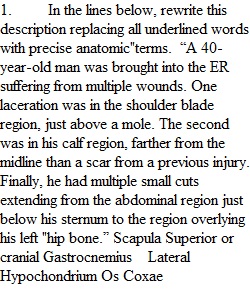


Q For this assignment, you will complete the Conceptual Thinking prompts below. These prompts are based on your Chapter 1 readings. Please carefully read the instructions and each question. Some questions will include activities, while others will include questions that will require you to "fill-in-the-blank" or provide a long-form answer. Note that long-form answers should be at least 50 to 100 words in length. Additionally, please format your responses with the correct question number (1) or question letter (A) that correlates to your answer. Your responses should be submitted as a file upload. HINT: Copy and paste the Conceptual Thinking prompts into a Word or Google document; this will allow you to type in your response to each question! If you have any questions, please reach out to your instructor! ________________________________________ Chapter 1 - Conceptual Thinking 1. In the lines below, rewrite this description replacing all underlined words with precise anatomic"terms. “A 40-year-old man was brought into the ER suffering from multiple wounds. One laceration was in the shoulder blade region, just above a mole. The second was in his calf region, farther from the midline than a scar from a previous injury. Finally, he had multiple small cuts extending from the abdominal region just below his sternum to the region overlying his left "hip bone.” ______________________________ ______________________________ ______________________________ ______________________________ ______________________________ ______________________________ 2. Look back at the case study at the beginning of the chapter, and answer the following questions. A. What was the main challenge to Mike’s homeostasis (hint: the numbers involved are 80 and 40)? B. How did his heart try to compensate for this challenge? C. Which body system contains the heart? D. Find two medical interventions performed by the paramedics that helped Mike deal with his homeostatic challenge. 3. A disease at the chemical level can have an effect on the whole body. That is, a change in a chemical affects a cell, which alters the functioning of a tissue, which disrupts an organ, which disrupts a system, which results in body dysfunction. Illustrate this concept by rewriting the following description in your own words using the different levels of organization in order of complexity: chemical, cell, tissue, organ, system, and body (hint: blood is a tissue). Your answer should address the following issues: (a) Which of the bold terms applies to each level of organization? (b) Which level of organization is not explicitly stated in the question? Mr. S. experiences pain throughout his body. The movement of blood through his blood vessels is impaired. His blood cells are misshapen. A chemical found in red blood cells called hemoglobin is abnormal. ______________________________ ______________________________ ______________________________ ______________________________ ______________________________ ______________________________ 4. Read the following description carefully. Then, identify the components of the negative feedback loop by writing the correct bolded term in each blank. NOTE: you will not use all of the bolded terms. Victoria was at the doctor's office for her annual checkup. As she was lying on the bed, her systolic blood pressure was measured at 110 mm Hg. Her physician was happy with the reading, mentioning that the average systolic blood pressure for a woman her age was between 100 mm Hg and 120 mm Hg. When Victoria stood up, she felt dizzy for a second but then recovered. The physician reassured her, mentioning that baroreceptors found in some of her arteries were able to detect the decrease in blood pressure that happens when we stand up. The vasomotor center in her brain sent signals down nerves to her heart in order to increase the heart rate and increase blood pressure. A. regulated variable ______________________________ B. sensor(s) ______________________________ C. effector(s) ______________________________ D. control center(s) ______________________________ E. set point ______________________________ Rubric Homework - Conceptual Thinking in A&P Homework - Conceptual Thinking in A&P Criteria Ratings Pts This criterion is linked to a Learning OutcomeQuestion 1 6 pts This criterion is linked to a Learning OutcomeQuestion 2 4 pts This criterion is linked to a Learning OutcomeQuestion 3 6 pts This criterion is linked to a Learning OutcomeQuestion 4 5 pts Total Points: 21 PreviousNext
View Related Questions